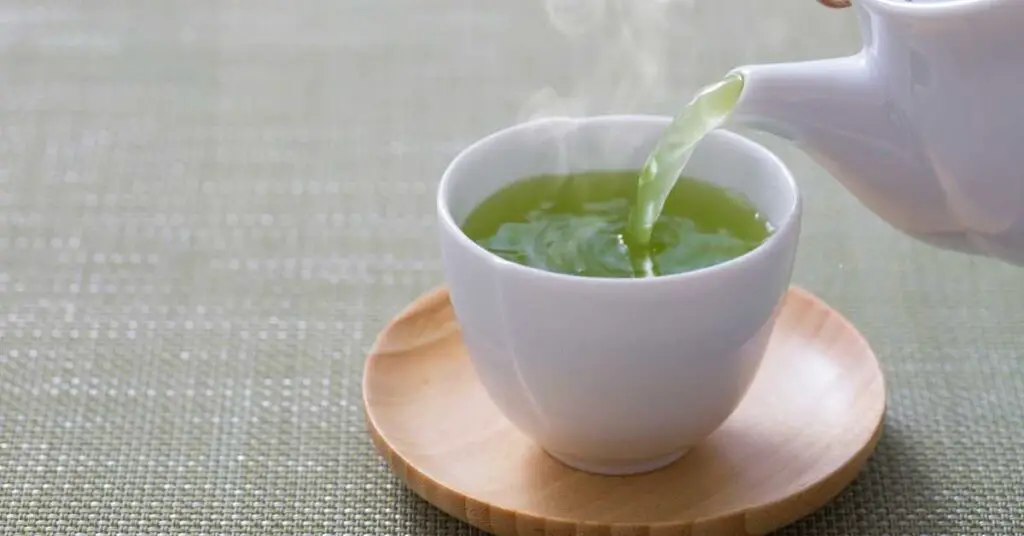Welcome, intrepid travelers, to a captivating odyssey through the timeless world of Japan’s traditional tea ceremonies. Within the hushed sanctuaries of Chashitsu, where every gesture speaks volumes, we embark on a journey steeped in history, philosophy, and reverence.
From the genesis of tea in ancient monasteries to the refined elegance of formal Chaji gatherings, each step is a brushstroke on the canvas of this revered art form. With every Chawan cradled and every bow exchanged, we unlock the secrets of a practice that transcends mere tradition—it’s a dance of harmony, a meditative experience, a cultural tapestry woven with threads of grace and respect.
Join us, dear reader, as we traverse this enchanting path of Japanese tea ceremonies. 🍵🌿
Also read: Discovering the ancient Chinese tea ceremonies.
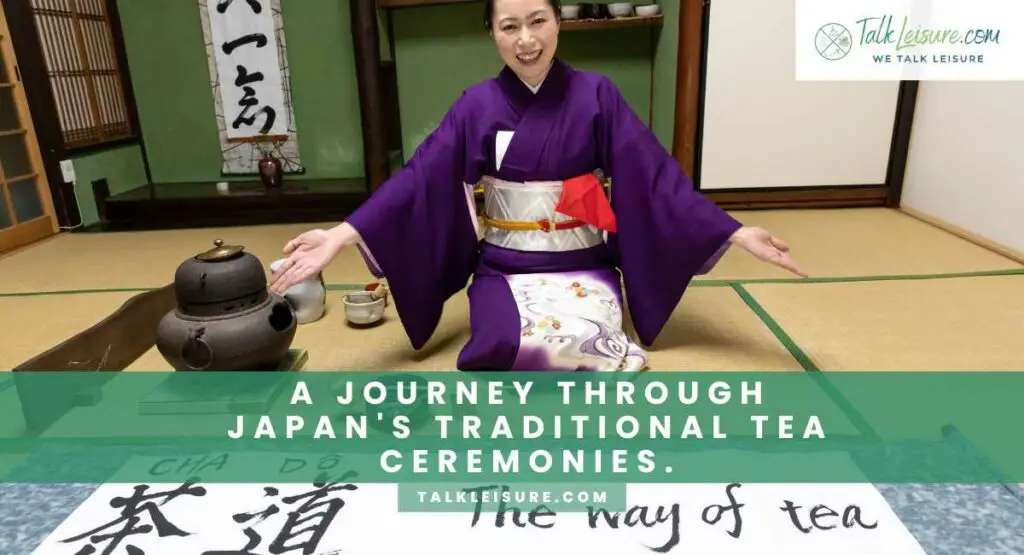
Introduction to Japanese Tea Culture
Hey there, fellow tea enthusiasts and curious minds! Today, we’re embarking on an enchanting journey through the heart of Japan’s rich tea culture. As we sip our way through centuries-old traditions and intricate rituals, you’ll come to discover that tea in Japan is not just a beverage but a profound cultural experience.
The Steeped History
Imagine stepping back in time to a Japan of yesteryear, where monks and scholars embarked on a quest to bring forth a newfound appreciation for the delicate art of tea. It all began with seeds and scrolls, as ancient Chinese tea wisdom found its way across the sea. The yearning for spiritual enlightenment and the appreciation of nature gave birth to something truly extraordinary.
Tea Ceremonies: Where Culture and Zen Converge
In Japan, tea ceremonies are more than just a sip and a chat. They’re a dance of harmony between the host, the guest, and the elements around them.
With roots deep in Zen Buddhism, each movement and gesture hold a profound meaning. It’s a meditative experience, a moment of serene connection with the universe.
Now, you might be wondering, “Why all the fuss over tea?” Well, my friend, it’s not just about a beverage; it’s about a philosophy. The ceremony itself is a journey, a story woven with silk threads of tradition and respect, with every fold and crease echoing the wisdom of centuries.
As we delve deeper, we’ll uncover the essence of the tea room, the significance of the utensils, and the delicate artistry of the tea scroll. These are not just objects; they are the vessels that hold the soul of the ceremony.
So, fasten your seatbelts, or rather, tie your obi (kimono sash), as we set forth on this voyage to unearth the mysteries and magic of Japan’s traditional tea ceremonies. Let’s unravel the layers of history, brush off the dust of time, and sip from the cup of tradition. Get ready to experience tea like never before! 🍵
Also read: The delightful world of tea-infused desserts and pastries.
Origins and Evolution of Japanese Tea Ceremonies
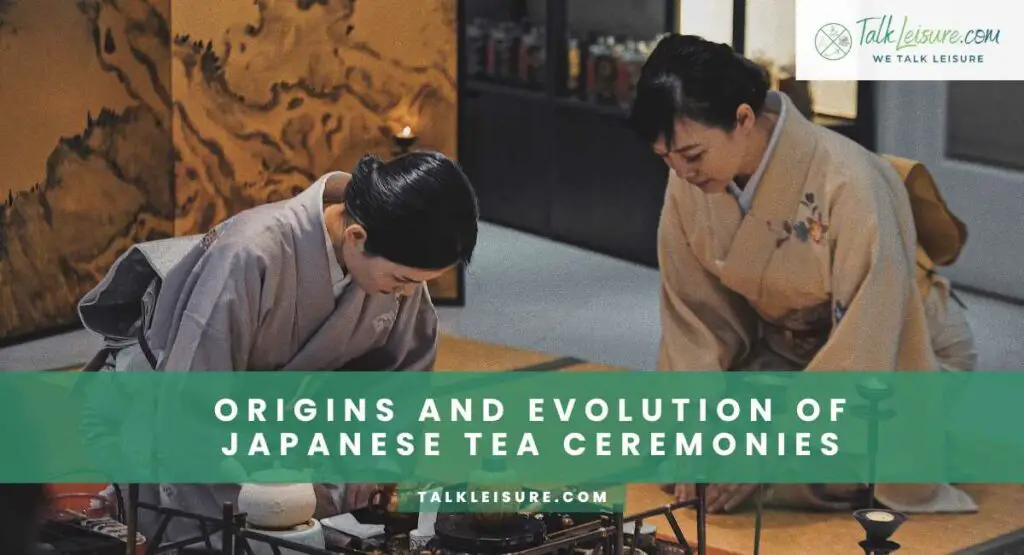
Welcome, curious minds, to the fascinating realm of the origins and evolution of Japan’s revered tea ceremonies. To truly understand the beauty of today’s ceremonies, we must first turn the pages of history and journey back to the roots of this ancient art form.
The Genesis: Monks, Seeds, and Serenity
Picture a serene monastery nestled amidst the lush landscapes of ancient Japan. It was here, in the early days, that the seeds of tea were sown – both literally and metaphorically. Monks, seekers of spiritual enlightenment, introduced this sacred leaf, transforming it into a conduit for meditation and mindfulness.
With meticulous care, they nurtured the tea plant, extracting not just leaves, but a philosophy; a way of life. This act marked the inception of what would become one of Japan’s most cherished traditions.
Heian Elegance: The Birth of a Ritual
Fast forward to the Heian period, a time of refined arts and graceful pursuits. Tea, once a humble leaf, began to take on a new significance. The intricate dance of preparation and presentation evolved into a ritual, captivating hearts and minds alike.
During this era, the concept of “Wabi-Sabi” took root, emphasizing simplicity and the beauty in imperfection. This philosophy would go on to shape the very essence of Japanese tea ceremonies.
Zen’s Embrace: Where Mindfulness Meets Matcha
As the winds of time continued to blow, the profound influence of Zen Buddhism swept across Japan. The marriage of Zen principles with the art of tea ceremonies elevated this practice to a spiritual experience. Every gesture, every movement, took on a deeper significance, a reflection of the Zen ideal of being present in each moment.
The Zen masters, with their keen eye for subtleties, honed the ceremony into a refined dance of harmony. It became a meditation in motion, an avenue for enlightenment, and a path to inner peace.
Today, as we step into the world of Japanese tea ceremonies, we are not merely observing a ritual; we are immersing ourselves in a living history, a tapestry woven with threads of ancient wisdom, spiritual enlightenment, and boundless respect for nature.
So, dear reader, as we journey forward, keep in mind the monks who nurtured the first leaves, the poets who found solace in simplicity, and the Zen masters who turned this ceremony into a meditative masterpiece. We’re about to explore the very essence of tea’s evolution in Japan. Stay tuned! 🍃🍵
Also read: How to care for and maintain your precious tea sets.
Key Elements of Japanese Tea Ceremonies
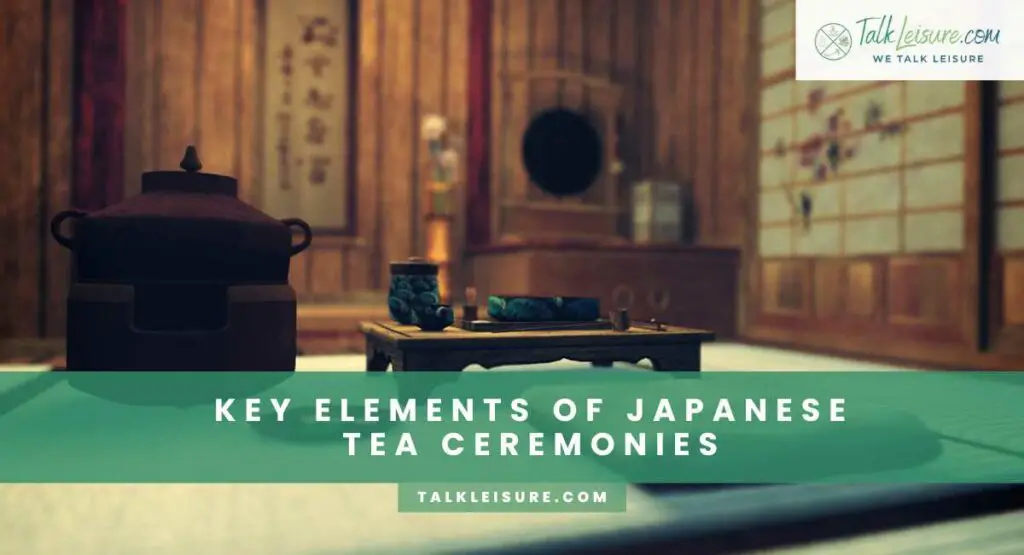
Ah, the heart of the matter! As we embark on this exploration of Japanese tea ceremonies, it’s crucial to understand the elemental pieces that compose this intricate puzzle. Each element, carefully chosen and thoughtfully placed, plays a vital role in the orchestration of this beautiful ritual.
The Sanctum: Unraveling the Chashitsu
First and foremost, let’s step into the hallowed ground of the tea room, known as the Chashitsu. This is not just any room; it’s a sanctuary meticulously designed to enhance the ceremony’s ambiance. The tatami mats underfoot, the gentle play of natural light, the fragrance of incense lingering in the air—every aspect is curated to induce a sense of calm and tranquility.
The proportions of the room, the arrangement of the utensils, even the placement of the guests—all are meticulously considered. It’s a space where time seems to slow, and the outside world fades away, allowing participants to fully immerse themselves in the ceremony.
Tools of the Trade: Chadogu and Their Significance
Now, let’s turn our attention to the star players of the ceremony—the Chadogu, or tea utensils. These are not mere tools; they are extensions of the ceremony’s spirit. The Chawan (tea bowl) cradles history, its shape and glaze telling tales of artisans’ hands. The Chasen (bamboo whisk) is a work of art, its delicate prongs frothing matcha into a silky emerald elixir.
And then there’s the Chashaku (tea scoop) – a slender instrument, almost like a conductor’s baton, guiding the tea leaves with grace and precision. Each utensil has its role, its purpose, and its place in the dance of the ceremony. Together, they form a harmonious ensemble, creating a symphony for the senses.
The Silent Narrator: Kakemono and Decorative Accents
As we gaze around the tea room, our eyes are drawn to the Kakemono, a hanging scroll that adorns the space. It’s not just decoration; it’s a silent narrator, setting the tone and theme for the ceremony. The choice of calligraphy, the brush strokes, the subject matter – all are carefully selected to evoke a specific mood or emotion.
Additionally, decorative elements like seasonal flowers, incense burners, and lacquerware add layers of aesthetic appeal. They bring a touch of nature into the room, a reminder of the ever-changing beauty that surrounds us.
So, dear reader, as we familiarize ourselves with these key elements, remember that they are not just objects; they are the essence of the ceremony. They hold history, philosophy, and artistry within their form. Together, they create a stage upon which the tea ceremony unfolds, inviting us to witness and partake in a tradition that transcends time.
Stay tuned, for in our next section, we’ll explore the various types of Japanese tea ceremonies and the unique experiences they offer. 🍵🌿
Types of Japanese Tea Ceremonies
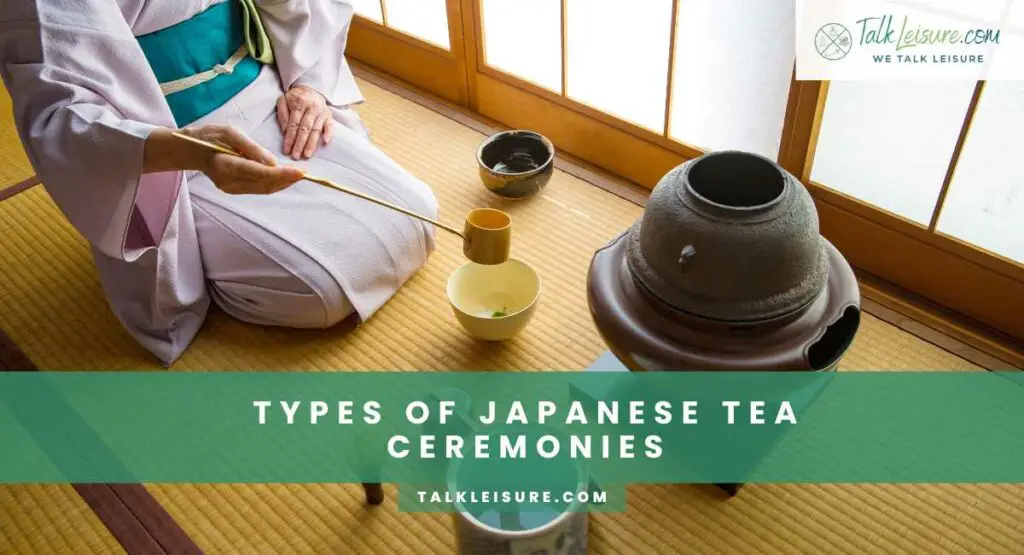
Ah, the world of Japanese tea ceremonies is a diverse tapestry, woven with various threads of tradition and formality. As we journey deeper, let’s uncover the different types of ceremonies that grace Japan’s cultural landscape.
The Formal Elegance of Chaji
First in our spotlight is the Chaji, the epitome of formal tea gatherings. Picture a meticulously choreographed performance, where every movement and gesture is executed with grace and precision. This is not merely a ceremony; it’s a symphony of tradition, an ode to respect and reverence.
A Chaji is a multi-course affair, comprising a kaiseki meal, various servings of tea, and confections that are harmoniously curated to complement each other. The host, akin to a maestro, orchestrates the proceedings, guiding guests through a sequence of meticulously planned moments. This is where the pinnacle of tea ceremony artistry is on full display.
The Intimate Chakai: Where Informality Meets Warmth
On the flip side, we have the Chakai – an intimate tea gathering that leans towards a more relaxed and informal setting. It’s like a friendly soirée, where conversation flows freely, and the atmosphere is characterized by warmth and camaraderie.
During a Chakai, guests are served a lighter meal, along with a single bowl of matcha. While the proceedings are less structured than a Chaji, the essence of respect and appreciation for the tea ceremony remains at the forefront. It’s an opportunity for participants to connect on a more personal level, allowing the spirit of the ceremony to shine through in a different light.
Al Fresco Beauty: Nodate
For those who seek a touch of nature in their tea experience, there’s the Nodate, or outdoor tea ceremony. Picture this: a serene garden, the gentle rustling of leaves, and the earthy scent of freshly brewed tea wafting through the air. It’s an enchanting fusion of natural beauty and ceremony.
During a Nodate, guests gather in an open-air setting, surrounded by the splendor of nature. The ceremony is simplified, allowing the surroundings to take center stage. This type of ceremony exemplifies the deep connection between tea culture and the appreciation of the natural world.
So, dear reader, as we explore these various types of Japanese tea ceremonies, remember that each offers a unique experience, a different facet of the rich tapestry that is tea culture in Japan. Whether you find yourself in the refined elegance of a Chaji, the warm embrace of a Chakai, or the natural beauty of a Nodate, one thing is certain: you’re in for a memorable journey through the heart of Japanese tradition.
In our next section, we’ll delve into the fascinating figures who have shaped the world of tea ceremonies. Stay tuned! 🍵🌸
Tea Masters and Schools
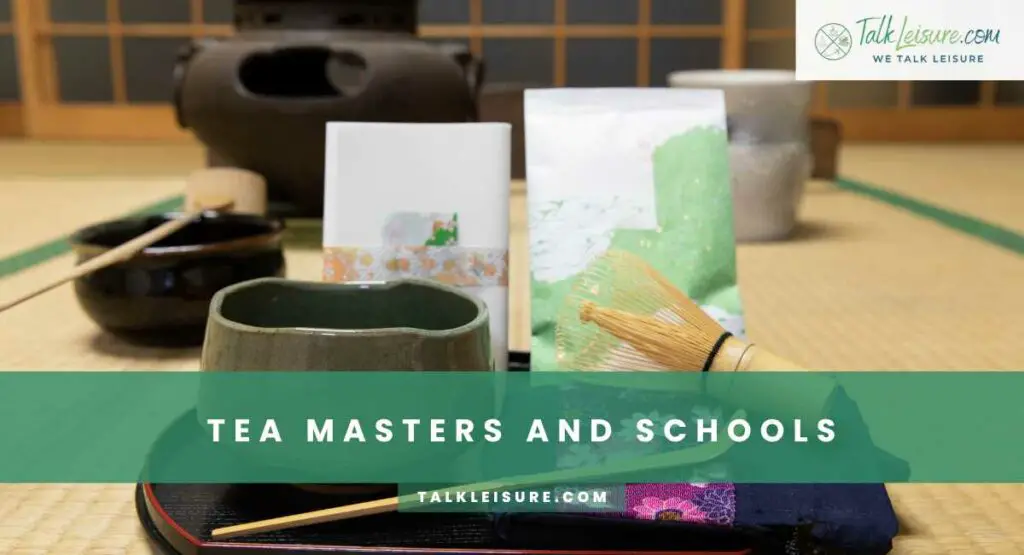
Ah, dear reader, now we venture into the realm of tea masters, the visionary figures who have left an indelible mark on the art of Japanese tea ceremonies. These maestros, with their keen insights and unwavering dedication, have shaped the course of this cherished tradition.
Sen no Rikyu: The Grand Master of Simplicity
Our journey would be remiss without paying homage to Sen no Rikyu, a name synonymous with the refinement of tea ceremonies. Rikyu, who lived during the 16th century, was more than a mere tea master; he was a philosopher, an artist, and a pioneer of the “Wabi-Sabi” aesthetic.
Rikyu’s contributions are immeasurable. He distilled the essence of tea ceremonies to their purest form, emphasizing simplicity, tranquility, and the beauty found in imperfection. His teachings continue to influence the practice to this day, ensuring that the spirit of tea ceremonies endures through the ages.
Urasenke, Omotesenke, and the Legacy of Schools
As we navigate the world of Japanese tea ceremonies, we encounter the distinguished schools that have nurtured and preserved this ancient art. The Urasenke and Omotesenke schools, in particular, stand as stalwarts in the realm of tea ceremony education.
The Urasenke school, founded by Sen Sotan, a descendant of Sen no Rikyu, is known for its emphasis on approachability and accessibility in tea ceremonies. Omotesenke, on the other hand, traces its lineage back to Sen no Rikyu himself. This school places a strong emphasis on preserving the traditional forms and rituals of tea ceremonies.
These schools are not just institutions; they are living repositories of knowledge, each contributing to the diverse tapestry of tea ceremony practice. Through their teachings, they ensure that the flame of this tradition continues to burn brightly, passed down from one generation to the next.
Innovators and Trailblazers
As we explore the world of tea masters, we also encounter modern innovators who have redefined the boundaries of tea ceremony artistry. Their experimental approaches and creative interpretations breathe new life into this ancient tradition, attracting a fresh wave of enthusiasts.
From Soen Nagatani, who pioneered the use of sencha (green tea) in ceremonies, to contemporary artists who blend traditional aesthetics with modern sensibilities, these innovators inject vitality into the practice, ensuring that it remains dynamic and relevant in a rapidly changing world.
So, dear reader, as we pay tribute to these luminaries, let their legacy inspire you as we journey deeper into the world of Japanese tea ceremonies. With their guidance, we’ll come to appreciate not only the roots of this tradition but also its boundless potential for growth and evolution.
In our next section, we’ll unravel the intricate steps of a traditional tea ceremony. Stay tuned! 🍵📜
Steps of a Traditional Japanese Tea Ceremony
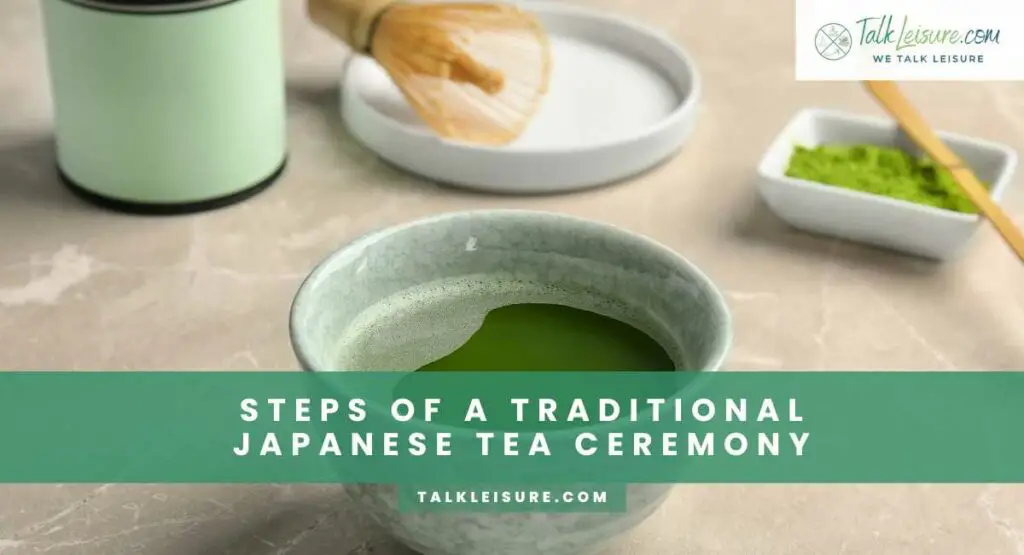
A dear fellow traveler on this tea-infused odyssey, we now find ourselves at the very heart of the matter: the intricate steps that define a traditional Japanese tea ceremony. Each movement, each gesture, is a brushstroke on the canvas of this ancient art form.
Harmony in Preparation
The stage is set. The tea room is a sanctuary of serenity, the utensils gleam with quiet anticipation, and the guests sit in hushed reverence. The host, clad in the graceful folds of a kimono, steps forward, signaling the beginning of the ceremony.
The first act is one of meticulous preparation. With measured grace, the host arranges the utensils, a choreography born of centuries of tradition. The Chawan, with its earthy beauty, is cradled in the palm of the hand. The Chasen, like a dancer poised for a pirouette, awaits its cue. And the Chashaku, like a conductor’s baton, hovers in poised stillness.
The Dance of Water and Leaves
Next, the water is heated to just the right temperature, a dance of fire and patience. The matcha, vibrant green and finely ground, is carefully measured and placed in the Chawan. With the grace of a calligrapher, the host pours the water, a dance of precision and intuition, until the tea achieves the perfect consistency.
The Chasen comes to life, its prongs a blur of motion as they whisk the matcha into a frothy elixir. This, dear reader, is the heart of the ceremony, where the elements—water, tea, and motion—come together in a symphony of creation.
The Offering: Presenting the Tea
With the matcha prepared, the host offers the bowl to the first guest, who accepts it with a bow, acknowledging not just the tea but the spirit in which it is given. The guest takes a moment to appreciate the Chawan, turning it in their hands like a cherished treasure.
Then, with a sip, they commune with the tea, allowing its essence to wash over them. The ceremony ccontinues, witheach guest receiving their turn to partake in this intimate exchange of tea and camaraderie.
A Moment of Gratitude
As the tea ceremony draws to a close, there is a moment of reflection, a pause for gratitude. The guests expressed their appreciation for the host’s meticulous care, for the tea, and for the shared experience. It is a moment of quiet connection, a culmination of the ceremony’s essence.
And with that, the dance concludes. The utensils are cleansed, each returned to its resting place, a ritual of closure and renewal.
So, dear reader, in these carefully choreographed steps, we find the heart of the tea ceremony. Each movement, and each gesture, is a testament to the centuries of tradition that have shaped this art form. As we move forward, let’s delve into the etiquette that underpins these graceful proceedings.
In our next section, we’ll explore the nuances of behavior and etiquette in a Japanese tea ceremony. Stay tuned! 🍵🌸
Tea Ceremony Etiquette
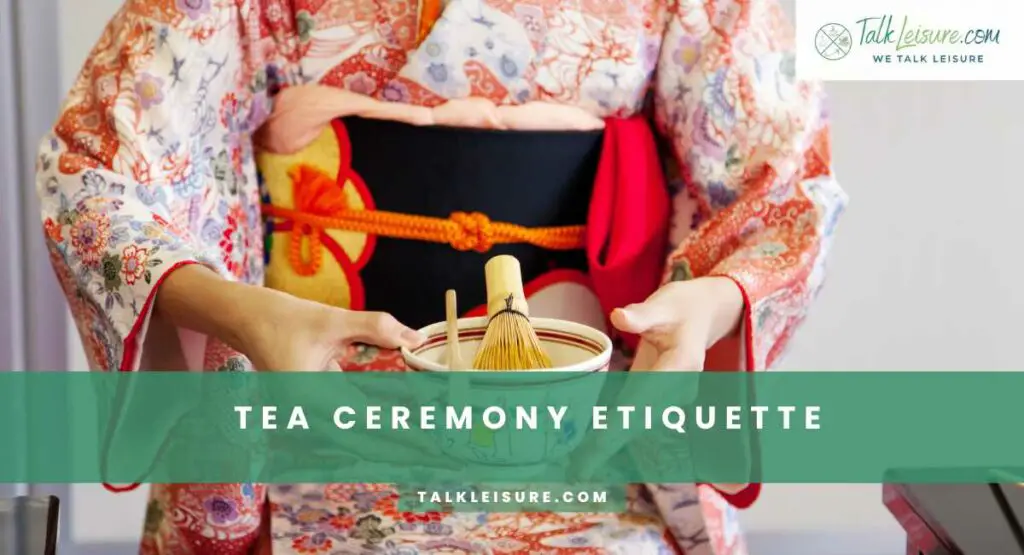
Ah, dear reader, as we step further into the world of Japanese tea ceremonies, it’s imperative to understand the delicate dance of etiquette that accompanies this ancient art form. Like the notes of a melody, each gesture and behavior holds profound meaning, adding depth and resonance to the ceremony.
The Dance of Attire: Dressing for the Occasion
Picture the scene: a serene tea room, guests seated in quiet anticipation, the host poised to begin. Attire, in the world of tea ceremonies, is more than mere clothing; it’s a reflection of respect for the tradition and the occasion.
For guests, wearing a kimono or other formal attire is not just a matter of style, but a gesture of reverence for the ceremony. It’s a way of immersing oneself in the timeless spirit of the event, a mark of respect for the host and fellow participants.
The Language of Gestures
As the ceremony unfolds, observe the language of gestures – subtle bows, graceful movements, and respectful hand placements. These are not mere formalities; they are the silent dialogues that weave through the ceremony, conveying respect, gratitude, and appreciation.
The bow, in particular, is a cornerstone of tea ceremony etiquette. It’s a gesture that transcends words, a symbol of mutual respect between host and guest. It acknowledges the shared experience and sets the tone for the proceedings.
Handling Utensils with Grace
In the delicate world of a tea ceremony, the utensils are not just tools; they are extensions of the ceremony’s soul. Handling them requires a touch of reverence and a measure of skill.
The Chawan, for instance, is cradled in both hands, a gesture of care and appreciation. The Chasen is whisked with a gentle, yet purposeful motion, a dance of precision. And the Chashaku, that slender implement, is used with a practiced hand, a mark of mastery.
Silence as a Symphony
In the tea room, silence is not empty space; it’s a canvas upon which the ceremony is painted. It allows the participants to immerse themselves fully, to appreciate the nuances of each movement, each sip. It’s a symphony of presence, a space where words are unnecessary.
Even in conversation, the words chosen are measured and considered, an acknowledgment of the solemnity of the occasion. It’s a dance of mindfulness, a reminder to be present in each moment.
So, dear reader, as we navigate the world of tea ceremony etiquette, remember that it’s not about rigid rules, but about an expression of respect and appreciation. It’s a language of gestures, a silent dialogue that binds host and guest, tradition and moment.
As we move forward, we’ll explore the regional variations that add a unique flavor to Japanese tea ceremonies. In our next section, we’ll embark on a journey to discover the distinctive practices of different tea-producing areas. Stay tuned! 🍵🌏
Conclusion
As our journey through Japan’s traditional tea ceremonies draws to a close, we find ourselves enriched by a profound cultural experience. From the serene Chashitsu to the choreography of gestures, we’ve unraveled the artistry and philosophy that infuse each ritual. The legacy of tea masters like Sen no Rikyu and the enduring traditions of Urasenke and Omotesenke schools have left an indelible mark on this practice.
Through etiquette, we discovered a language of respect and mindfulness. The ceremony’s essence, a blend of history, spirituality, and elegance, lingers in our senses. This journey isn’t just a voyage in tea; it’s an immersion in Japan’s soul. 🍵🌸
Frequently Asked Questions
- What does the Japanese tea ceremony teach?
The Japanese tea ceremony imparts lessons of mindfulness, respect, and the appreciation of simplicity. It teaches the value of being present in each moment, fostering a deep connection with both nature and fellow participants. Through precise movements and gestures, it cultivates a sense of grace and harmony, instilling a profound understanding of cultural heritage and spiritual significance.
- Who was involved in the Japanese tea ceremony?
The Japanese tea ceremony typically involves a host and guests. The host, often trained in the art of tea, orchestrates the ceremony, carefully preparing and serving matcha. Guests, seated in a prescribed arrangement, receive and partake in the tea. Their behavior and gestures play a crucial role in the ceremonial dance, creating a harmonious and respectful atmosphere.
- How do Japanese make tea?
Japanese tea, particularly matcha, is prepared with meticulous care. The host heats water to a specific temperature, then adds it to a bowl containing finely ground matcha. Using a bamboo whisk, they briskly whisk the mixture until it achieves a frothy, smooth consistency. The resulting vibrant green concoction is then served to guests in a ceremonious manner, embodying centuries of tradition and precision.







